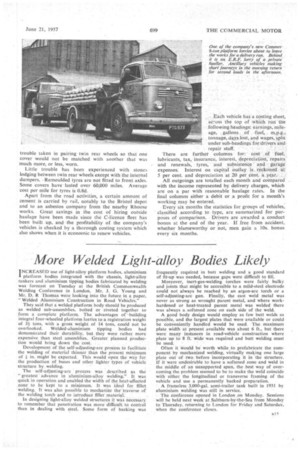More Welded Light-alloy Bodies Likely
Page 49

If you've noticed an error in this article please click here to report it so we can fix it.
INCREASED use of light-alloy platform bodies, aluminium platform bodies integrated with the chassis, light-alloy tankers and aluminium tipping bodies fabricated by welding was • forecast on Tuesday at the British Commonwealth Welding Conference in London. Mr. J. G. Young and Mr. D. R Thomas were looking into the future in a paper, "Welded Aluminium Construction in Road Vehicles."
They said that a welded platform body should be produced as welded sub-assemblies, bolted or -riveted together to form a complete platform. The advantages of building integral four-wheeled platform lorries to a registration weight of 3+ bans, with a gross weight of 14 tons, could not be overlooked. Welded-aluminium tipping bodies had demonstrated their durability, but they were rather rnore expensive than steel assemblies. Greater planned produc
tion would bring down the cost. . •
Development of the self-adjusting-arc process to facilitate the welding of material thinner than the present minimum of k in. might be expected. This would open the way for the production of buses and other lighter types of vehicle structure by welding.
The self-adjusting-arc process was described as the "greatest advance in aluminium-allay welding." It was quick in operation and enabled the width of the heat-affected zone to be kept to a minimum. It was ideal for fillet welding. it was also possible to mechanize the traverseof the welding torch and to introduce filler .material;
In designing light-alloy welded structures it was necessary to remember that penetration was more difficult to control than in dealing with steel. Some form of backing was frequently required in butt welding and a good standard of fit-up was needed, because gaps were difficult to fill.
Moreover, inert-gas-welding torches were fairly bulky and joints that might be accessible to a mild-steel electrode could not always be reached by an argon-arc torch or a self-adjusting-arc gun. Finally, the cast weld metal was never as strong as wrought parent metal, and where workhardened or heat-treated parent metal was welded there was always a softened zone on each side of the weld.
A good body design would employ as few butt welds as possible, and the largest plates that were available or could be conveniently handled would be used. The maximum plate width at present available was about 6 ft., but there were many instances in road-vehicle construction where plate up to 8 ft. Wide was required and butt welding must be used.
Often it would be worth while to prefabricate the component by mechanized welding, virtually making one large plate out of tWo before incorporating it in the structure. If it were undesirable to have a softened zone and weld in the middle of an unsupported span, the best way of overcoming the problem seemed to be to make the weld coincide with either, the longitudinal or transverse framing of the vehicle and use a permanently backed preparation.
A frameless 3,000-gal. semi-trailer tank built in 1931 by aluminium welding was still in service.
• The conference opened in London on Monday. Sessions will be held next week at Saltburn-by-the-Sea from Monday to Thursday, returning to London for Friday and Saturday, when the conference closes.




























































































